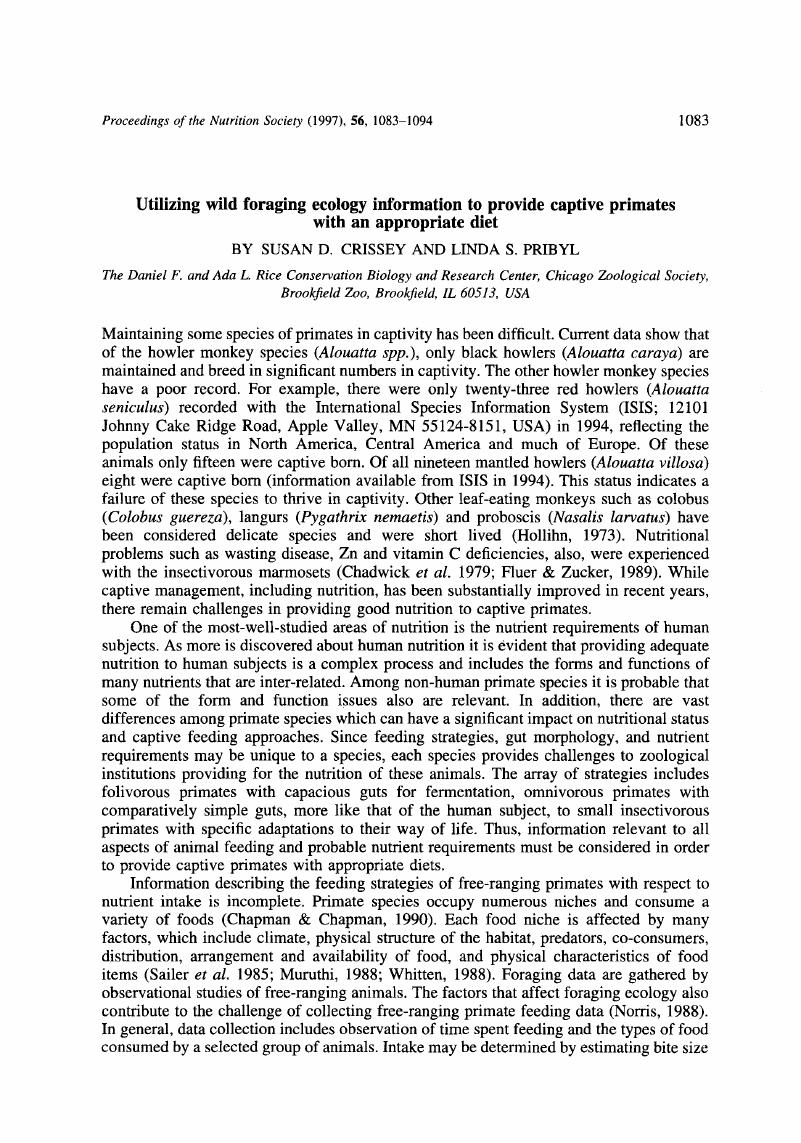Crossref Citations
This article has been cited by the following publications. This list is generated based on data provided by Crossref.
Speakman, John
1997.
Factors influencing the daily energy expenditure of small mammals.
Proceedings of the Nutrition Society,
Vol. 56,
Issue. 3,
p.
1119.
Benbow, S. Mary P.
2004.
Death and Dying at the Zoo.
The Journal of Popular Culture,
Vol. 37,
Issue. 3,
p.
379.
Fashing, Peter J.
Dierenfeld, Ellen S.
and
Mowry, Christopher B.
2007.
Influence of Plant and Soil Chemistry on Food Selection, Ranging Patterns, and Biomass of Colobus guereza in Kakamega Forest, Kenya.
International Journal of Primatology,
Vol. 28,
Issue. 3,
p.
673.
Struck, Katie
Videan, Elaine N.
Fritz, Jo
and
Murphy, James
2007.
Attempting to reduce regurgitation and reingestion in a captive chimpanzee through increased feeding opportunities: a case study.
Lab Animal,
Vol. 36,
Issue. 1,
p.
35.
Urquiza‐Haas, Tania
Serio‐Silva, Juan Carlos
and
Hernández‐Salazar, Laura Teresa
2008.
Traditional nutritional analyses of figs overestimates intake of most nutrient fractions: a study of Ficus perforata consumed by howler monkeys (Alouatta palliata mexicana).
American Journal of Primatology,
Vol. 70,
Issue. 5,
p.
432.
Ange-van Heugten, Kimberly D.
van Heugten, Eric
Timmer, Saskia
Bosch, Guido
Elias, Abahor
Whisnant, Scott
Swarts, Hans J. M.
Ferket, Peter
and
Verstegen, Martin W. A.
2009.
Fecal and Salivary Cortisol Concentrations in Woolly(Lagothrix ssp.)and Spider Monkeys(Ateles spp.).
International Journal of Zoology,
Vol. 2009,
Issue. ,
p.
1.
Soulsbury, Carl D.
Iossa, Graziella
Kennell, Sarah
and
Harris, Stephen
2009.
The Welfare and Suitability of Primates Kept as Pets.
Journal of Applied Animal Welfare Science,
Vol. 12,
Issue. 1,
p.
1.
Nakamura, Noriko
Amato, Katherine R.
Garber, Paul
Estrada, Alejandro
Mackie, Roderick I.
and
Gaskins, H. Rex
2011.
Analysis of the hydrogenotrophic microbiota of wild and captive black howler monkeys (Alouatta pigra) in palenque national park, Mexico.
American Journal of Primatology,
Vol. 73,
Issue. 9,
p.
909.
Power, Michael L.
Toddes, Barbara
and
Koutsos, Liz
2012.
Nonhuman Primates in Biomedical Research.
p.
269.
Etiendem, Denis Ndeloh
and
Tagg, Nikki
2013.
Feeding Ecology of Cross River Gorillas (Gorilla gorilla diehli) at Mawambi Hills: The Influence of Resource Seasonality.
International Journal of Primatology,
Vol. 34,
Issue. 6,
p.
1261.
Guzmán-Caro, Diana Carolina
and
Stevenson, Pablo R.
2014.
The Woolly Monkey.
p.
93.
Reiner, Whitney B.
Petzinger, Christina
Power, Michael L.
Hyeroba, David
and
Rothman, Jessica M.
2014.
Fatty acids in mountain gorilla diets: Implications for primate nutrition and health.
American Journal of Primatology,
Vol. 76,
Issue. 3,
p.
281.
Smith, B.K.
Remis, M.J.
and
Dierenfeld, E.S.
2014.
Nutrition of the captive western lowland gorilla (Gorilla gorilla gorilla): A dietary survey.
Zoo Biology,
Vol. 33,
Issue. 5,
p.
419.
Williams, Emma
Cabana, Francis
and
Nekaris, K. A. I.
2015.
Improving diet and activity of insectivorous primates in captivity: Naturalizing the diet of Northern Ceylon gray slender loris, Loris lydekkerianus nordicus.
Zoo Biology,
Vol. 34,
Issue. 5,
p.
473.
Amato, Katherine R.
Metcalf, Jessica L.
Song, Se Jin
Hale, Vanessa L.
Clayton, Jonathan
Ackermann, Gail
Humphrey, Greg
Niu, Kefeng
Cui, Duoying
Zhao, Hongxia
Schrenzel, Mark D.
Tan, Chia L.
Knight, Rob
and
Braun, Josephine
2016.
Using the gut microbiota as a novel tool for examining colobine primate GI health.
Global Ecology and Conservation,
Vol. 7,
Issue. ,
p.
225.
Clayton, Jonathan B.
Al-Ghalith, Gabriel A.
Long, Ha Thang
Tuan, Bui Van
Cabana, Francis
Huang, Hu
Vangay, Pajau
Ward, Tonya
Minh, Vo Van
Tam, Nguyen Ai
Dat, Nguyen Tat
Travis, Dominic A.
Murtaugh, Michael P.
Covert, Herbert
Glander, Kenneth E.
Nadler, Tilo
Toddes, Barbara
Sha, John C. M.
Singer, Randy
Knights, Dan
and
Johnson, Timothy J.
2018.
Associations Between Nutrition, Gut Microbiome, and Health in A Novel Nonhuman Primate Model.
Scientific Reports,
Vol. 8,
Issue. 1,
Matsuda, Ikki
Bernard, Henry
Tuuga, Augustine
Nathan, Sen K. S. S.
Sha, John C. M.
Osman, Ismon
Sipangkui, Rosa
Seino, Satoru
Asano, Sanae
Wong, Anna
Kreuzer, Michael
Ramirez Saldivar, Diana A.
and
Clauss, Marcus
2018.
Fecal Nutrients Suggest Diets of Higher Fiber Levels in Free-Ranging than in Captive Proboscis Monkeys (Nasalis larvatus).
Frontiers in Veterinary Science,
Vol. 4,
Issue. ,
Rogers, Lesley J.
Stewart, Leanne
and
Kaplan, Gisela
2018.
Food Calls in Common Marmosets, Callithrix jacchus, and Evidence That One Is Functionally Referential.
Animals,
Vol. 8,
Issue. 7,
p.
99.
Pebsworth, Paula A.
Huffman, Michael A.
Lambert, Joanna E.
and
Young, Sera L.
2019.
Geophagy among nonhuman primates: A systematic review of current knowledge and suggestions for future directions.
American Journal of Physical Anthropology,
Vol. 168,
Issue. S67,
p.
164.
Frankel, Jeffrey S.
Mallott, Elizabeth K.
Hopper, Lydia M.
Ross, Stephen R.
and
Amato, Katherine R.
2019.
The effect of captivity on the primate gut microbiome varies with host dietary niche.
American Journal of Primatology,
Vol. 81,
Issue. 12,



